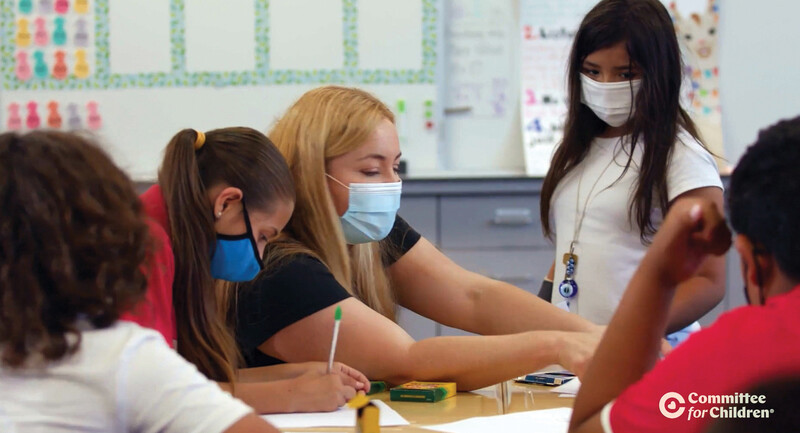My student (let's call him Mark) stood in my doorway looking exasperated. "Nadine shoved me across the hall, so I elbowed her back, but only I got in trouble," he told me. "Teachers let the girls get away with everything." Like many 7th graders, Mark is highly attuned to injustice, sensitive to perceived criticism, and motivated by the desire for approval and respect.
I asked Mark if he wanted to share his frustration with the teacher who disciplined him, but he responded with a firm no. "She'll just hate me even more," he said. His effort to stuff down his feelings failed when he began calling out random words ("Swimming pool! Matchbox!") in class. Most of his classmates gawked, but their discomfort didn't stop him. When I asked him later why he chose to be silly, he didn't hesitate: "Because everyone knows I'm an idiot, and I hate myself."
It's not easy to be a tween or to teach one, but it's much easier to connect with 10- to 14-year-olds when you appreciate their strengths and understand their distinct characteristics. Middle schoolers want to make meaningful contributions, but they may withdraw or lash out if they feel that someone is squelching their voice. They may baffle or offend you, but they're often just as confusing to themselves.
They're also still learning. A teacher I work with once reacted negatively to a 6th grade boy who kept insisting that there was no gender wage gap. As a school counselor and therapist, I recommended she start from a place of curiosity and ask him to provide his proof. When the boy produced a random blog, she directed him to a more reputable source. He softened his stance, and the teacher realized it was more productive to start with questions than to jump to judgment.
I've spent years translating young adolescents' needs into developmentally appropriate, evidence-based strategies for those who teach them. Here are five ways you can bring out the best in this age group.
1. Shadow a student for a day.
In my middle school, every staff member shadowed a student for an entire day. You can't empathize with tweens' struggles or expect them to consider others' perspectives unless you're willing to step into their shoes. Observe a student you don't know very well. Interview them about their highs and lows. Log detailed notes about the student's daily experience and apply what you learn to your teaching practices. You might find out that the student you thought had friends eats by himself in the hallway or that the child who never raises her hand comes alive in physical education. One teacher discovered that a student who was sure that everyone hated him had many friends. From then on, she tried to help him get an accurate read on feedback instead of letting him wallow in negativity.
2. Communicate that you're ready to be an emotional support.
Teachers often adhere to "stay in your lane" thinking. Your plate is full, and you may feel ill-equipped to help a child in emotional pain. But the suicide rate among 10- to 14-year-olds doubled from 2007 to 2014. Tweens are more likely than older adolescents to deny or miss the signs that they're struggling. At a time when the American School Counselor Association reports an average student-to-school counselor ratio of 406 to 1, middle schoolers may feel more connected to their teachers than to their counselor. To build your comfort self-identifying as a helper, consider taking a Youth Mental Health First Aid or counseling course. At minimum, walk your students to their counselor and help them share their story.
Similarly, recognize that you may need to drop everything during a lesson to attend to an emotional issue. One stray comment can derail a middle schooler's whole day, let alone their ability to solve a math problem. Setting academics aside might be disruptive in the short run but improves trust and attention spans in the long run.
To figure out who needs extra care, some teachers use mental health check-in chartsor mood notes that enable students to communicate distress in discreet ways. Teachers can privately check in with students who indicate that they're feeling miserable or anxious.
Middle schoolers lack life experience and often have no idea how to center themselves, so coping strategies are important, too. I've had kids write their favorite strategies on wooden craft sticks and cart them around in a pencil case. Whenever they're in a panicky or low place, they can pick a stick. Or, make it a class exercise: Have everyone write an idea and put them in a large jar; students can choose a strategy and test a classmate's approach. My students have suggested taking deep breaths, tossing and catching a ball in the air, doing wall push-ups, or getting a drink of water. They've also come up with mantras such as, "I'm going to be as kind to myself as I am to my friends" and "I don't have to get everything right all the time."
3. Make reflection part of the learning process.
At an age when kids desperately crave approval and have a limited understanding of their strengths and weaknesses, group projects can be challenging. Middle schoolers may be overly invested in the result and fail to embrace others' ideas. Conversely, they may slack off and leave the work to more diligent classmates.
To help students learn to collaborate, ask students to self-assess their personality traits and what they might need in a group member to strike the right balance at the outset of a project. Teachers also can prompt students to write about how they think their group is doing, asking at regular checkpoints: "Is the workload distributed fairly? If it is uneven, what could you change to ensure that everyone contributes?" Teachers can then provide individual feedback to students so that they have a chance to shift gears if they're being too domineering or hands-off. Students also can keep a personal journal and reflect on the experience: "What strengths did I bring? What would I do differently next time? How did I regroup when I got off course?"
4. Be intentional about embracing differences.
Middle schoolers have lots of questions, including, "Who am I?" and "Am I good enough?" Be intentional about fostering a healthy self-identity. If educators can teach middle schoolers to embrace differences and practice inclusion when they're at their most self-conscious, they'll internalize that they themselves deserve to be treated with respect, too.
To move the dial, bring in speakers who look like your students, diversify the curriculum, talk about divisive or upsetting issues in the news that affect your students, and bring any fears or biases to the surface. For example, you can invite groups of kids who don't normally interact to have lunch with you in your classroom or encourage your school to periodically assign seating in the cafeteria. The goal isn't to dictate what students should think or whom they should befriend, but rather to move them from a place of awkwardness to one of understanding.
To illustrate that everyone has a backstory, use writing prompts such as, "I wish others knew …" and read texts that bust stereotypes, such as Monica Harwell's StoryCorps narrative about being the first woman to climb electric utility poles for Con Edison. Kids this age also benefit from having a safe space, such as an affinity group, where they can explore salient aspects of their identity with like-minded peers.
5. Give students voice.
Middle schoolers need to assert autonomy, which means they're going to rebel at times. They'll be less likely to do so if you talk above their age and maturity level and involve them in rule generation. Whether you're establishing bathroom break rules or cell phone policies or looking to improve an assignment, make it clear that you welcome their ideas and feedback. You can use Google Docs or a shoebox to collect students' thoughts.
At my school, students have opportunities to lead class discussions and teach their peers. We entrust 8th graders to spearhead schoolwide service projects, decide where to donate money from fundraisers, organize game nights and dances, lead assemblies, and speak to younger grades about community norms and expectations.
Empowerment can also come in more subtle forms. I once asked a few middle school students who struggled with anxiety to make stress balls for younger students. They met on several occasions to share their favorite ways to unwind. Another time, I invited an 8th grader who was adopted to share her perspective with younger students in an adoption affinity group. At the time, the girl was insecure about her academic ability and often cut class. She was surprised when the kids greeted her with excitement and peppered her with endless questions. Almost overnight, her attitude toward school improved.
As I have learned, even seemingly small tasks can build middle schoolers' self-efficacy, give them a sense of agency, and increase their willingness to comply with expectations and contribute to their school community.









